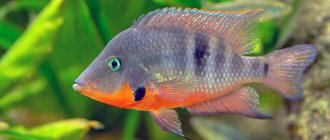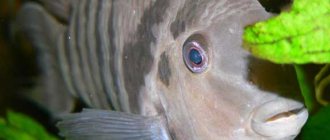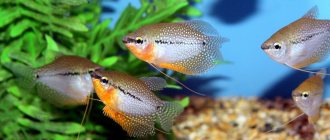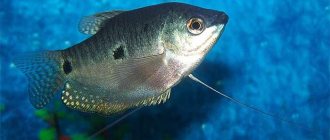Sacbranch catfish - keeping in a home aquarium
Fish leads a fairly active lifestyle, so its life activity is associated with the production of large amounts of waste.
The water should be changed regularly. In general, the optimal water parameters are as follows: pH: 6.0–8.0, hardness 5–30°H, water temperature 21–25 °C. Water changes should be carried out 1–2 times a week, the total volume of changes should not exceed 10–15% of the total volume of water. Catfish feed exclusively on animal food. You can add live worms to the diet mixed with dry food or separately from it. Also, catfish will not refuse meat, fish fillets and shrimp. Among store-bought foods, Neon Blood Worms, Sera Viformo, Tetra Pleko Min, Tetra Tabi Min and some others are good options.
When planning to keep fish in an aquarium, you should take into account both the living conditions of the fish in nature and nutrition. The size of the aquarium is not of fundamental importance, but you need to understand that the larger the aquarium, the larger the catfish will grow. Therefore, it is best to keep catfish in a large aquarium with plenty of hiding places, but it is also necessary to provide enough open space to allow swimming.
You need to create shelters in the aquarium - grottoes and caves, driftwood, fragments of ceramic pipes or inverted clay pots with a side hole. But the bottom of the artificial reservoir should not be cluttered - at night, when the owners are sleeping, the catfish actively swims: it hunts. You should avoid decoration elements that have sharp edges: the skin of a catfish is very delicate, and it can get hurt. The aquarium must be very sealed, even through small holes the fish can get out.
Social behavior: In one aquarium, if the volume and bottom area allows, you can keep several pouchbranch catfish. You cannot combine them with other benthic species - quarrels over territory may arise. Large, active fish species are suitable as neighbors. Small fish will be eaten by catfish, as this species is a nocturnal predator.
Breeding
The sacbranch catfish reaches sexual maturity in the second year of life. The male, ready for spawning, becomes covered in spots. To increase the likelihood of a positive spawning result, the method of pituitary injections is used.
A couple that is ready to reproduce is moved to a spawning area. When arranging it, you should remember the behavioral characteristics of fish. It should contain secluded places and plants. The water volume is at least 100 liters, the temperature is higher than in the main aquarium: 27-28° C. A mesh is placed on the bottom.
All active activity of catfish begins at night, and spawning is no exception. The female lays eggs in shelters, producing about 500-600 eggs at a time. They are small balls with a diameter of 2-3 mm with red nucleoli. At the end of spawning, the parents return to the main home.
On the third day the fry emerge. From now on they need food. It is most advisable to use artemia as the first food. As they grow, gradually switch to adult food. It should be noted that the water level in the spawning tank should not exceed 20 cm, because the respiratory organs of the fry develop gradually and they need access to the surface to survive. A fry that has reached a length of 5 cm is considered a full-fledged teenager. Now it can be moved to the main aquarium.
Look at the albino sacbranchs.
Having familiarized yourself in more detail with the peculiarities of life activity and the rules of care, we can conclude that the sacbranch catfish will not go unnoticed even in the darkest corner of the aquarium, and will not cause much trouble to its owner. He, like no one else, will be able to attract attention with his beauty and mystery.
The decisive factor when choosing neighbors should be the fact that catfish are predators, so it is better not to add them to fish that can become dinner for the catfish. It is best to house catfish with other large predators such as catfish and cichlids. With good care, catfish live quite a long time: the maximum life expectancy of catfish in captivity is about 20 years.
An aquarium of at least 150 liters is required for maintenance.
We invite you to read: Treating calcivirosis in cats at home, symptoms, consequences and treatment regimen
Like most catfish, the sacbranch catfish is shy. For this reason, it leads a twilight and nocturnal lifestyle, and hides in shelters during the day. In this regard, the tank of domestic catfish should have strong caves made of stone slabs and a large number of floating plants. Lighting should be dim.
Any interior design should not have sharp edges, since fish have delicate skin that is easily injured. There must be a lid on top so that the inhabitants do not leave their home. A powerful filter and aeration device are installed, since the interbranch catfish heavily pollutes the aquatic environment during its life processes.
Optimal biotope parameters:
- temperature regime 20-28 C;
- hardness 4-16 dH;
- acidity 6.6-7.6 pH.
Once every 7 days, replace part of the water volume, by about a quarter.
As aquarium pets, sacbranch catfishes are problematic. They are gluttonous, restless and pugnacious.
Catfish only tolerate a lack of oxygen in water in nature. The water in the aquarium for them should be clean and fresh. It is also necessary to provide access to the surface so that the fish can breathe air.
They are difficult to keep because without appropriate experience in handling them, you can suffer from injections of poisonous thorns. However, you need to strongly provoke the catfish so that they start stabbing with their whiskers. Sometimes this can cause serious consequences. After a bite, it is recommended to immediately immerse the affected limb in hot water so that the venom coagulates.
Hardly anyone can stand being in the vicinity of these catfish. Therefore, it is necessary to keep them in a species aquarium.
Nutrition and lifespan
According to reviews from avid aquarists, the sacbranch catfish loves to eat hearty and tasty. He is omnivorous. Its diet consists mainly of animal food. Worms separately and mixed with dry food, shrimp, fish fillets - the catfish will not refuse these dishes. It feeds both at the bottom and while floating up. Do not overfeed this “glutton”. It swallows food completely, so it is very important for the health of the fish that the pieces are not large.
Once a week, spend fasting days for him. The fry should be fed with brine shrimp. How long the sacbranch catfish lives depends on care and living conditions. The lifespan is a minimum of 8 - a maximum of 20 years.
Breeding
Clarias photography
Breeding clarius at home is extremely difficult, since clarius needs space for successful reproduction. For breeding, a flock of clarius is started and kept together until they split into pairs. Then the couples are seated separately. Several pairs are not kept in one aquarium in order to avoid fights.
In their natural environment, during spawning, clarius dig a hole on the sandy shore to lay eggs. When kept in captivity, dig a hole at the bottom of the aquarium. The female lays more than a thousand eggs. Until the eggs hatch into larvae, the male will guard them; in the future, the female will take on these responsibilities. It is better to catch the fry and remove them from their parents.
From the very beginning of its life, Clarius shows its predatory qualities. You can feed the fry with chopped tubifex, brine shrimp, and bloodworms. The fry grows very quickly and as it grows, the size of its prey should also increase. The fry should be fed carefully, in small portions and several times a day. They are truly insatiable.
Clarius photo
Due to its somewhat frightening appearance, Clarius cannot be called a common aquarium fish. However, having acquired this unusual and very easy-to-keep fish, the aquarist over the years will be able to discern its hidden charm and comprehend its subtle character. Moreover, he will have as much as 20-25 years to do this, because the Clarius catfish is a real long-liver.
Puberty in the sacbranch catfish occurs in the second year of life and may be accompanied by a change in color. To create good conditions for reproduction, it is necessary to equip a spawning tank, the volume of which should be approximately 100 liters. Its contents should be similar to the main aquarium.
On average, a female can produce about five hundred eggs. These catfish do not build special nests for their future offspring, but they try to arrange them in some kind of shelter. Only the male guards the eggs and takes care of the young. However, it is best to place the parents in a community aquarium immediately after spawning and replace a quarter of the water. The larvae are born within a day. Unfertilized and whitened eggs will pollute the spawning area, so they must be removed in time.
The fry are formed already on the third or fourth day after fertilization. Initially, their respiratory organs are not well developed, so they often have to rise to the surface of the water in order to receive a sufficient amount of oxygen. Given this feature, the level of the water column should not exceed 20 cm.
The fry are transplanted into the main aquarium only when they reach 5-6 cm in length. It is worth noting that they grow unevenly, so you need to monitor their development and remove the largest individuals in time, as they can start fights over territory and eat their smaller counterparts.
We suggest you familiarize yourself with: Swordtails maintenance and care compatibility reproduction
Compatibility
The sacbranch catfish is a predator that is suitable for a species aquarium. You cannot keep small fish with him, otherwise they will become his prey. For him, a solitary existence is preferable. The fish is active in the dark, and during the day it likes to climb into some shelter or bury itself in the mud.
Often, catfish of this species are quite peaceful, but sometimes they can sort things out with their neighbors, fighting for their territory. On rare occasions, they show aggression, but only when they are attacked. The sacbranch catfish can be kept in an aquarium with small fish, but only until it outgrows them. As soon as it becomes larger than them, it is better to move small guppies, angelfish, zebrafish and telescopes to another aquarium.
Large species such as labeo, polypterus, barbs, rainbowfish, cichlids, calamoikhtas and gourami can become good neighbors for catfish. Also, sometimes parrot fish are added to his aquarium. Considering that the catfish most often stays near the bottom, you can also keep various riding species of fish with it.
Habitat and description
Nepal, Vietnam, Bangladesh, Thailand, Sri Lanka, India. It is found in US water bodies, where it was introduced artificially for breeding and has become a serious problem for the fauna of American rivers. The large and predatory clarius, in the absence of natural enemies, grew in large numbers and became a serious threat to the population of local fish species. The only reason Clarius has not been able to spread throughout America is its intolerance to cold weather. In winter, the catfish dies.
Catfish in their natural environment live in fresh, swampy creeks with turbid water and low oxygen content. It is widespread in the following areas:
- Nepal;
- Sri Lanka;
- India;
- Bangladesh;
- Pakistan;
- Iran.
During periods of drought and lack of food, it can freely move overland from reservoir to reservoir if the journey takes no more than 2 hours. Its main secret is air sacs connected to the gills and a high production of secretion that moisturizes its skin. The sacs evolved from the swim bladder. His body was rebuilt in accordance with its environment.
The fish is large, the size of sacbranch catfish reaches 50 cm in nature, while in aquariums it is limited to 30 cm, but this depends on the food and the size of the jar. As you know, many catfish grow as long as their habitat allows.
Their “lungs” are located outside, stretching from the gills to the very tail. The body is laterally flattened, long. The abdomen is rounded. The head is flat, wider than the body, with four pairs of whiskers. The fins are radiant, the anal fins are large. The color ranges from dark to light brown, and albino sacbranch catfish are sometimes found.
The interesting thing is that it is poisonous; on its dorsal fin there is a long ray, which the catfish raises when sensing danger. The injection is painful and can cause harm to a person. A numbness is felt in the stung limb for several hours, which gradually increases, covering an increasingly larger area, so you need to be extremely careful with your pet.
Keeping sacbranch catfish fish leaves an imprint on life expectancy; they can live up to 7 years, but only if all conditions are met. Like all catfish, it is nocturnal. He doesn’t have any great care requirements, but you still need to provide him with comfortable living conditions:
- The size of the fish directly depends on the volume of the aquarium; the larger it is, the larger the catfish grows.
- The soil is soft, sandy with some pebbles.
- Water temperature is from 21 to 25 degrees Celsius.
- At the bottom you need to organize several shelters where the catfish can hide during the day. But free space is also necessary so that the fish can maneuver during the night hunt.
- The aquarium needs to be lit carefully; it should not be installed near a window, as sunlight will disturb the pet.
Interbranch catfish can live up to 7 years under favorable conditions - Vegetation won’t hurt either; it’s better to plant algae with a large root system, since catfish like to dig up roots.
- The jar should not contain decor with sharp or rough surfaces, otherwise the catfish may be injured. And because of its delicate skin, it is difficult to bear damage.
- The aquarium must be closed, otherwise the owner risks finding the pet on the floor in the morning.
- Most of the diet should consist of live food: shrimp, larvae, worms, fish fillets. But dry tablet food can also be included in small quantities.
- A powerful filter is required; aeration is needed for a modest-sized aquarium.
During night promenades, catfish sometimes rise to the surface with a characteristic splash; in silence, the sound terrifies unprepared people, and this must be taken into account. During the day, the pet is almost unnoticed; it rests either in algae thickets or in artificial shelters.
Since the fish are large, there will be a lot of organic waste. Keeping a sacbranch catfish involves weekly cleaning of the bottom, as well as water changes: 15-20% of the total volume.
We invite you to read: Description of the Havanese Bichon breed
Maintenance and care
photo can be enlarged
These catfish are unpretentious when it comes to food; they eat everything that is offered to them: live, dry, vegetable, frozen food. They love squid, shrimp, and sea fish, cut into small pieces. But you can’t overfeed catfish either; it’s advisable to leave one day in the middle of the week as a fasting day.
To keep a sacbranch catfish, you need a closed aquarium with a volume of at least 150 liters with various shelters (snags, caves), thickets of plants and free space for swimming. The lighting is diffuse. The soil is small pebbles. Water parameters for optimal maintenance of sacbranch catfish: hardness up to 20°, pH 6.5-7.5, temperature 21-25 °C. Constant filtration, aeration and weekly changes of up to 25% of the water volume are required.
Be careful when catching a sacbranch catfish with a net, as it has poisonous spines on its body. He is not aggressive and will not attack first, but if pressed he will defend himself.
Sacbranchial catfish are long-lived, and in optimal conditions they can live up to 12 years.
Choice of neighbors
If you want to add neighbors to your catfish, then you should choose them based on their size and temperament. Sac-branch catfish are extremely voracious; they are capable of mowing down all the small inhabitants in one night, so you should not add miniature fish to them.
It is better to pay attention to large breeds with a predatory character, such as:
- Astronotuses;
- Cyprinidae;
- Cichlids;
- other large aquarium catfish.
Cichlids are suitable aquarium neighbors for sacbranch catfish
Perhaps you should not keep it with only the red-tailed catfish; this inhabitant of aquariums is capable of eating almost anyone. And it grows faster than the sacbranch. In any case, there will be constant conflicts and serious night battles between this couple. Therefore, for the sake of peace of mind of household members, they should not be kept together.
The sacbranch catfish will decorate the aquarium for those who are fascinated by the inhabitants of the bottom. He is large, beautiful in his own way, and interesting to watch during periods of his activity. The maintenance is not very difficult even for beginners, but in this case it is better to keep one or a couple of them.
The sacbranch catfish (lat. Heteropneustes fossilis) is an aquarium fish that comes from the sacbranch family. This is a large (up to 30 cm), active predator, and even poisonous. Fish of this genus have two bags instead of lungs, running along the body from the gills to the tail itself. When the catfish reaches land, the water in the bags allows it to survive for several hours.
Habitat in nature
It occurs quite often in nature, distributed in Iran, Pakistan, India, Nepal, Sri Lanka, and Bangladesh. It is found in places with weak currents, often in stagnant water with excess oxygen - swamps, ditches and ponds. It can go into rivers and has even been seen in salt waters.
Important! Also known in the West as the stinging catfish, the sacbranch is not recommended for beginner aquarists due to its toxicity. The poison is contained in sacs at the base of the chest spines. A sacbranch sting is very painful, resembles a bee sting, and in some cases can cause anaphylactic shock. Naturally, you need to be extremely careful when cleaning the aquarium or catching fish. In case of a bite, the affected area should be immersed in as hot water as possible to coagulate the protein in the poison and consult a doctor.
Description
The habitat has left its mark on the sacbranch catfish. It can survive in conditions where there is very little oxygen in the water, but it needs access to the surface where it can breathe. In nature, the sacbranch catfish can leave a body of water and move overland to another. The structure of the lungs and abundant mucus help him in this, making it easier to move.
In nature it grows up to 50 cm long, in aquariums it is much smaller, no more than 30 cm. The body is elongated, laterally compressed. The belly is rounded. There are four pairs of whiskers on the head - on the lower jaw, nasal and upper jaw. Long anal fin with 60-80 rays, lateral fins 8 rays. The lifespan of the sacbranch catfish is 5-7 years; how long they live largely depends on the conditions of detention.
Body color ranges from dark to light brown. The albino sacbranch catfish is very rare, but can be found commercially. Its conditions of detention are the same as usual.
Best kept in semi-darkness with plenty of hiding places, but also an open area for swimming. There should be no sharp edges in the aquarium, as the fish have delicate skin. The aquarium must be closed, since the sacbranch catfish can get out even through a small hole in search of new bodies of water.
Predators go out hunting at night, so you can’t keep them with fish that they can swallow. And given their considerable size, the best neighbors for them are large catfish and cichlids. They are unpretentious in nutrition and maintenance, they eat any animal food, you can also add worms to the diet. Water parameters: pH: 6.0-8.0, hardness 5-30°H, water temperature 21-25 °C
Diseases and prevention
Despite the spartan living conditions in the wild, in the tank the saccobranch catfish is prone to diseases. Compliance with the rules of care and nutrition are important for this species.
The most common lesions:
- White rash is ichthyophthyriosis, an infectious disease usually caused by low-grade food, undisinfected soil or contaminated algae. Antibiotics are prescribed for treatment; consultation with a doctor is necessary before use.
- White cotton wool-like threads are a fungal infection that occurs against a background of weakened immunity. The reasons are poor nutrition and poor temperature control. Treatment begins immediately, in advanced stages, when internal organs are affected, the fish cannot be saved. At the first symptoms, antifungal drugs are used.
What are your food preferences?
It will not be a surprise to anyone to learn that such a catfish eats food of animal origin, not disdaining other smaller fish and their young.
Leading a nocturnal lifestyle, it ambushes its prey and eats everything that can fit in it.
He also does not refuse dry artificial food. It will appreciate chopped worms, minced meat or fish, and chopped shrimp. He eats a lot and often, which is why he grows. The larger the volume of the aquarium where such a resident lives, the larger the individual grows.
It will not eat plants, although their presence in the aquarium is mandatory. He uses them to hunt or hide from bright light.











